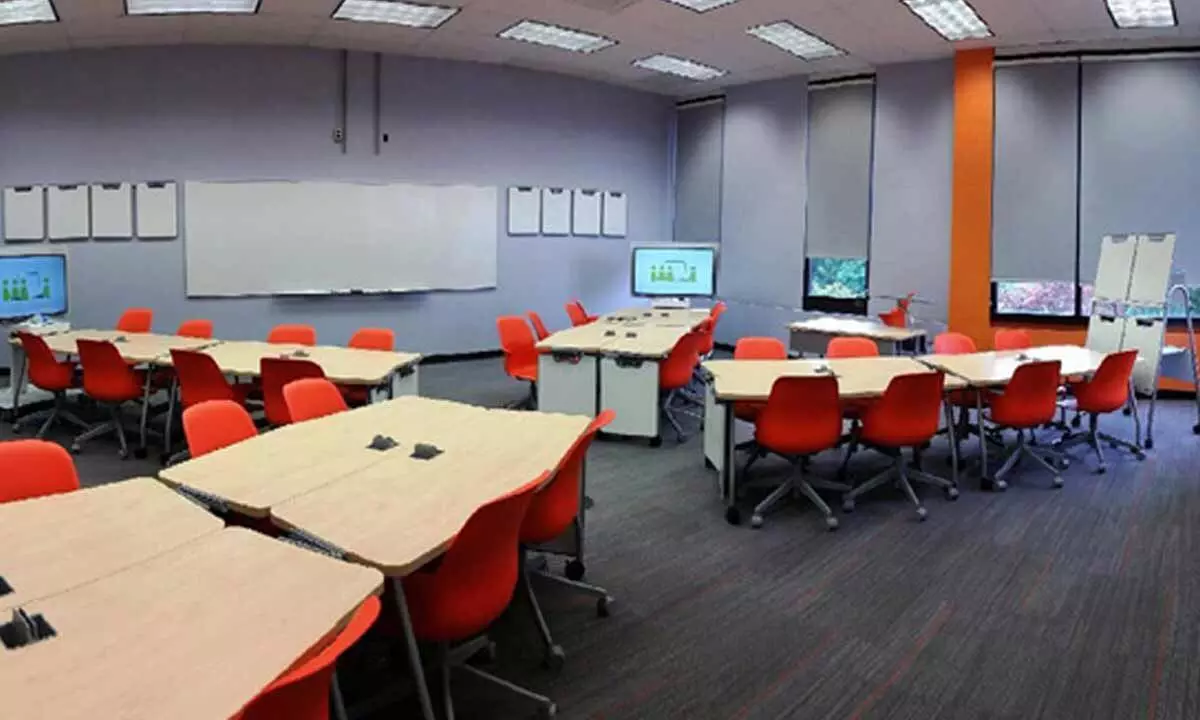Live
- India Faces Blow as Pacer Mohammed Shami Ruled Out for Remainder of Australia Series
- Biden Pardon: Joe Biden Commutes Death Sentences of 37 Inmates, Including Child Killers and Mass Murderers
- South Korea: Yoon believes impeachment trial takes priority over martial law probe
- Strict Action for Non-Adherence to Time Management - DMHO Dr. Swarajya Lakshmi
- Over 13.29 lakh houses approved for rural poor in Maharashtra: Shivraj Chouhan
- District Collector Urges Timely Completion of Indiramma Housing Scheme Survey
- Digital Arrest Scam: Hyderabad Man Duped of ₹7 Lakhs by Fake Crime Branch Police Callers
- Sukhbir Badal seeks President's Police medal for officer who saved his life
- US Firm Accordion Acquires Merilytics, Launches 1,500-Seater Office in Hyderabad
- Free Medical Camp Organized by Alampur Advocate Bar Association
Just In
Redefining classrooms for 21st-century education with innovative learning spaces


The dawn of the 21st century has brought a paradigm shift in various industries, and the education sector is no different.
The dawn of the 21st century has brought a paradigm shift in various industries, and the education sector is no different. Gone are the days when traditional educational institutes used to have a one-size-fits-all approach. With ever-changing needs and demands, innovative learning spaces that foster creativity, collaboration, and critical thinking are becoming more popular. As a result, educators are adopting new approaches to teaching and learning that redefine classrooms and better prepare students for future challenges.
Innovative learning space: An understanding
The education sector has witnessed some significant changes since the rise of technological innovations in the 21st century. From traditional classrooms to digital environments, learning has evolved at an astonishing pace, opening up a world of possibilities. Today's classrooms are more flexible and adaptable, designed to cater to various learning styles and activities. One of the most noteworthy developments is the emergence of innovative learning spaces, which have redefined the classroom for the current era of learning. These spaces are capable of evolving and adapting as educational practices change, making them future-focused. Innovative learning spaces prioritize student engagement and interaction, creating environments that inspire curiosity and exploration. So, let's take a closer look at the benefits of innovative learning spaces, which make the learning process more enjoyable and less tedious.
Benefits of innovative learning spaces
Make every class different: It's no secret that school can be monotonous for young students. The same routine of lectures, quizzes, and exams can make every day feel the same. However, the adoption of innovative learning spaces can break the humdrum and provide an engaging environment that keeps students motivated and excited to learn. These spaces bring everyone together and prepare students for success in the modern world.
Allow educators to cater to all learning styles: As we all know, traditionally, teaching has been limited to visual and oral methods such as writing on the board or providing slideshows. However, innovative learning environments emerge as a powerful component, providing hands-on, collaborative, and interactive learning experiences that can increase student engagement. When teachers cater to students' learning styles, students may feel more comfortable and confident in their studies.
Create a space that works better with technology: It's becoming increasingly crucial to design learning spaces that better align with modern technology. With the growing utilization of laptops and tablets in classrooms, outdated desks just don't cut it anymore. By integrating interactive whiteboards, charging stations, and movable seating arrangements, innovative learning spaces can provide an engaging and dynamic learning experience for students. Traditional desks are no longer practical, as they lack the functionality to allow students to move around and plug into an outlet as needed.
Innovative learning spaces: Redefining classroom for the future!
Gone are the days when teachers used to segregate students into distinct whiteboard groups or set up desks in a circle. The advent of innovative learning spaces has revolutionized the way learners interact with their environment and collaborate with their peers, creating a more dynamic and engaging learning experience. These spaces are purposefully designed to inspire creativity, critical thinking, and problem-solving abilities, equipping students with the necessary skills to thrive in a constantly changing world.
(The author is Managing Director, Birla Open Minds)

© 2024 Hyderabad Media House Limited/The Hans India. All rights reserved. Powered by hocalwire.com






